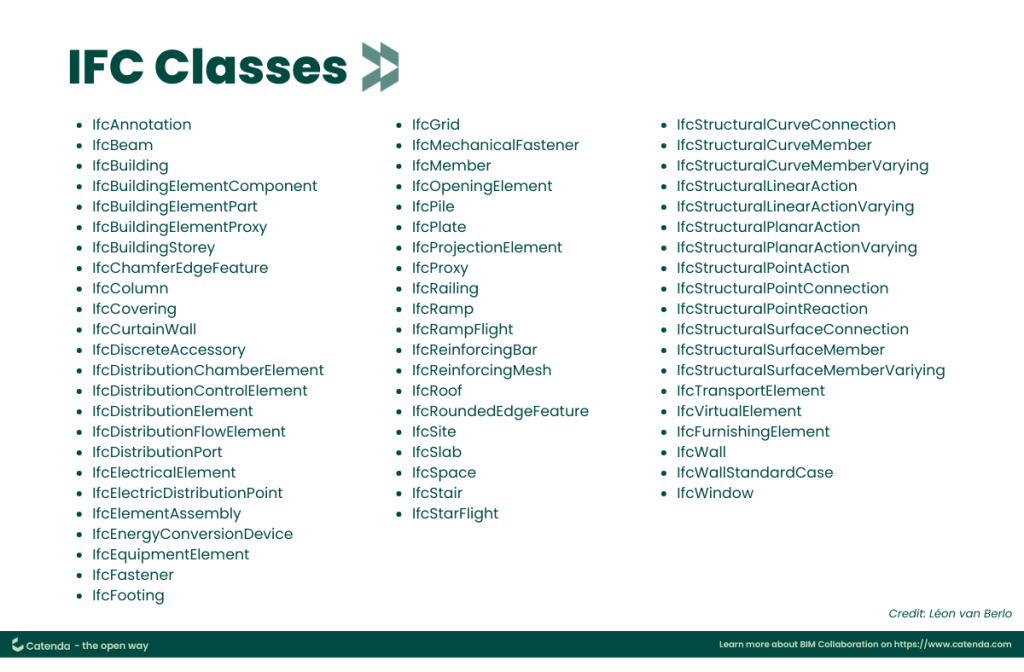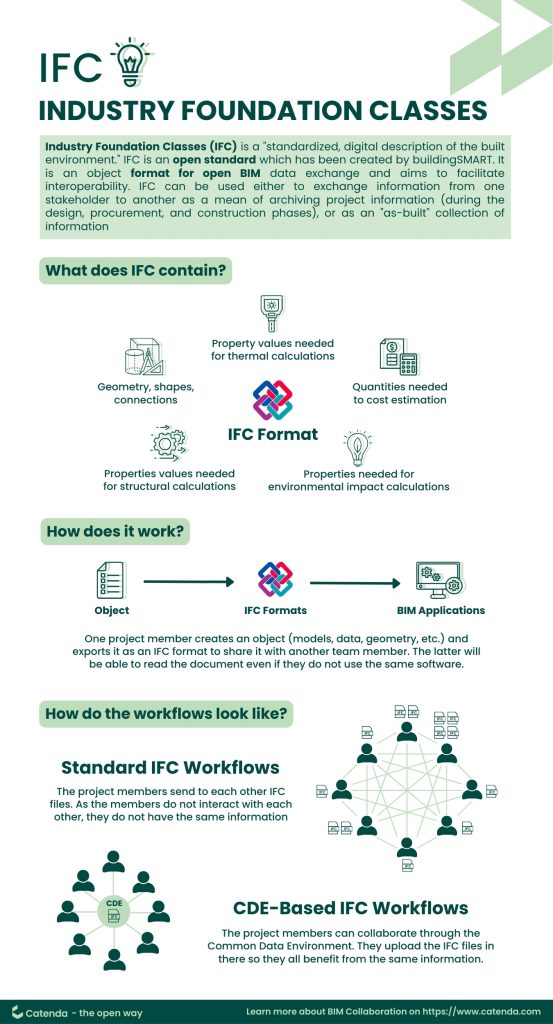What does IFC stand for and what is its role in construction?
What is an IFC file?
Industry Foundation Classes (IFC) files were coming from the STEP format, originating from the manufacturing industry (creating products in series). A format was needed that offered a common ground where information could flow continuously from one project member to another.
What is its role in BIM?
From the STEP format, the Architecture, Engineering and Construction industry (AEC) took a different road in 1994, evolving into the current IFC.
IFC serves as a standardized digital representation of the built asset industry. Functioning as an open, international standard (ISO 16739-1:2018), it advocates for vendor-neutral, agnostic features, ensuring usability across a wide range of hardware devices, software platforms, and interfaces for diverse use cases.
IFC is a standard for the open BIM data exchange. Therefore, it can be thought of as the PDF of Building Information Modeling (BIM). IFC files, like PDFs, are a frozen version of the original material. They can be viewed, measured, and used for cost estimation or simulation, among other things, but they are not intended to be modified. IFC is continuously improving since it is an open standard. That means that it is not a proprietary format, so anyone can contribute to improve or enhance it. IFC is organized and managed by buildingSMART. It is well documented; with resources available for everyone to see and access. That contributes to its durability.
Generating an IFC file captures a moment in your project. It is like taking a picture of a design, saving the view and issuing it as an IFC file. In other words, it is a snapshot. Any time there is a new revision, it means there is a new moment, so a new IFC is produced.
Many municipalities, private clients, project owners, contractors, and designers in building projects have integrated IFC BIM (Building Information Modeling) into their business. In countries like Norway, the government (The Norwegian Government, Health, and Defense) requires the use of IFC BIM on all projects.
What are the different versions and types of IFC format by buildingSMART?
The IFC standard has evolved over time to better accommodate the needs of the AEC industry, with several major releases by buildingSMART. The first version of IFC was released in 1996, followed by IFC1.5.1, IFC2.0, IFC2x, IFC2x2, IFC2x3, and the latest being IFC4.3 published recently in 2023. Each version represents an extension or improvement over its predecessor.
IFC formats and documentations
These versions of IFC have been encoded in various formats such as HTML, EXPRESS, XSD/XML, and OWL documentation and formats, allowing for flexible transmission over web services, import/export in files, or management in centralized or linked databases.
The IFC-SPF, based on the ISO standard for clear text representation of EXPRESS data models, is recommended for file-based import and export due to its wide compatibility and smaller file size.
IFC Schema Specifications
The IFC schema specification’s official releases are listed on the website of buildingSMART International.
The standards documentation, available through buildingSmart, is licensed under the Creative Commons Attribution-NoDerivatives 4.0 International License.
What is the importance of Industry Foundation Classes in construction?
People in the AECO industry, even though they are in competition to achieve some projects, all agree on one thing. Any project requires Information to Flow Continuously.
That is why we need IFC for building projects and structural analysis. The Industry Foundation Classes (IFC) are pivotal in the construction industry due to their role in facilitating effective information exchange and collaboration among different stakeholders involved in a building project. They serve as a common language, enabling interoperability among various software applications used in the sector.
This is particularly important in the context of Building Information Modeling (BIM), where data about a building’s physical and functional characteristics need to be shared across different software platforms. The open, non-proprietary nature of IFC ensures that these data exchanges are vendor-neutral, promoting a more inclusive and seamless digital workflow.
Moreover, IFC’s standardized digital description of the built asset industry allows for consistent representation of real building and construction industry objects, such as walls, doors, and windows, in a 3D digital model. This contributes to more accurate and efficient planning, design, and construction processes.
In general, the use of IFC in construction supports:
- Data Integrity: IFC ensures that data and information aren’t lost or distorted when transferred between different software applications.
- Data Exchange: Facilitates seamless exchange and sharing of data between different stakeholders and systems involved in construction projects.
- Efficiency: By facilitating interoperability, IFC reduces the need for rework and manual data re-entry, saving time and resources.
- Interoperability: IFC provides an open standard file format, enabling interoperability among diverse software applications used in the architecture, engineering, and construction (AEC) industry.
- Collaboration: IFC enables multiple stakeholders, from architects to contractors, to collaborate effectively on the same project, irrespective of the software they use.
- Error Reduction: Standardization helps reduce errors and inconsistencies that may arise from incompatible data formats or software applications.
- Industry Standard: Widely adopted as an industry standard, IFC contributes to a more standardized and structured approach to data management in the AEC sector.
Information loss?
IFC can be described as a container, for both data and properties. IFC files contain data related to objects, i.e., geometry and metadata with values attached. There are classes to describe multiple things so a lot of information can be packed into an IFC file. This box won’t loose data or any information provided. But, since it is a common ground, a minimum requirement for everyone, it is not necessary to add not every data because it won’t be useful to the other team members working on the same project.
IFC Classes

Any project requires IFC files. Sometimes, subcontractors work with very specific software that can produce IFCs, and you will need to integrate this in your workflow. Your customers and your clients might realize that the way to go and to store the information for the future is through the use of IFC files.
Any project requires IFC files. Sometimes, subcontractors work with very specific software that can produce IFCs, and you will need to integrate this in your workflow. Your customers and your clients might realize that the way to go and to store the information for the future is through the use of an open standard… and this is IFC.
If you want to discover a project case study explores the use of IFC files in overcoming real-world challenges, check it out here.




